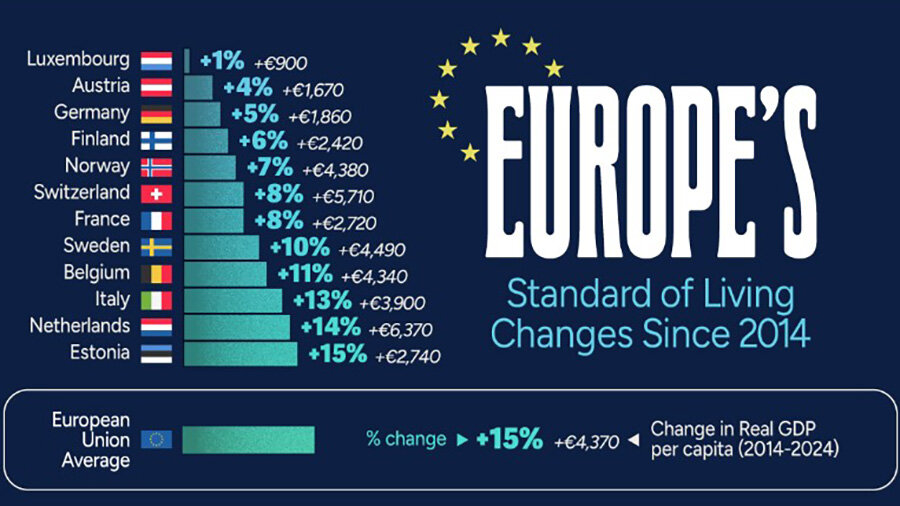читайте также
 Vietnam Struggles With Severe Flooding: Deaths Reported, Tourists Trapped
Vietnam Struggles With Severe Flooding: Deaths Reported, Tourists Trapped
 PwC: UK Hotel Market Remains Resilient in 2026 — Time for Innovation, Efficiency, and Strategic Growth
PwC: UK Hotel Market Remains Resilient in 2026 — Time for Innovation, Efficiency, and Strategic Growth
 Private Jet Rentals Redefine Luxury Travel: The Emerging Trend of 2025
Private Jet Rentals Redefine Luxury Travel: The Emerging Trend of 2025
 Formula 1 Grand Prix Brings Singapore’s Hotel Market to Record-Breaking Heights in October 2025
Formula 1 Grand Prix Brings Singapore’s Hotel Market to Record-Breaking Heights in October 2025
 Austria’s Real Estate Market Accelerates: Sales Up Nearly 14%
Austria’s Real Estate Market Accelerates: Sales Up Nearly 14%
 Cyprus Real Estate: Prices Rise, Returns Fall
Cyprus Real Estate: Prices Rise, Returns Fall
Analytics / Research / Ratings / Ireland / Poland / Serbia / Croatia / Bulgaria / Romania / Кипр / Litva / Turkey / Hungary / Slovenia / Slovakia / Germany / France / Italy / Greece / Portugal / Spain 25.04.2025
Living Standards in Europe: Where Life Improved the Most Over the Last Decade

New data published by Visual Capitalist shows how living standards across Europe have changed between 2014 and 2024. The key metric used in the analysis is real GDP per capita, adjusted for inflation and expressed in euros.
Eastern Progress, Western Stagnation
Topping the list is Ireland, where real GDP per capita increased by 75% over the decade. However, the report cautions that this growth is statistically inflated due to the presence of multinational companies engaging in transfer pricing and IP registration—profits that are counted in Ireland but do not reflect actual income for residents. The government recommends looking at Gross National Income (GNI) for a more realistic view.
The most authentic gains in living standards occurred in Eastern and Southeastern Europe:
- Serbia: +50%
- Croatia: +48%
- Bulgaria: +46%
- Poland: +45%
- Romania: +44%
- Cyprus & Malta: +40%+
- Lithuania, Turkey, Latvia, Hungary: +33–39%
- North Macedonia, Slovenia, Slovakia: +25–30%
Many of these countries benefited from:
- Manufacturing relocation from Western Europe
- Wage growth
- Higher domestic demand
- A low base effect amplifying percentage growth
For example, Serbia’s +50% equates to a gain of around €3,000 per capita—while France had a similar absolute gain but only an 8% relative increase due to its high starting point.
Case Study: Poland’s Transformation
Poland stands out as a success story—transitioning from a post-socialist economy to a high-growth market since joining the EU in 2004. Institutional reforms and EU investment flows played a major role. However, Poland now faces headwinds due to its dependence on German demand, exposing it to external volatility.
Western Europe: Slower Growth
Western Europe’s mature economies showed modest changes:
- Germany
- France
- Italy
- Greece
All saw increases in real GDP per capita in the 8–15% range over ten years. Structural maturity, aging populations, and limits to extensive growth are cited as the reasons. Italy and Greece, in particular, have yet to fully recover from past financial crises.
OECD Outlook: Reforms and Sustainable Growth
The OECD Economic Outlook provides further insight into long-term living standard trends. It predicts an average 1.2% annual growth in potential GDP per capita across the Eurozone (2020–2024), slightly below pre-crisis levels.
Some countries outperform:
- Greece: +1.9% in 2023 – highest in 15 years
- Portugal & Spain: 1.5–2% annually due to structural reforms, digitalization, and labor market changes
In contrast, Eastern Europe still leads in overall growth but faces a developmental ceiling. Without a shift toward innovation, automation, and human capital, the benefits of cheap labor and supply-chain integration may fade.
Forecast to 2030
OECD expects Eastern and Southern Europe to narrow the gap with Western Europe, with:
- Eastern Europe: potential growth of 1.8–2.5% per year, driven by tech adoption and domestic demand
- Western Europe: slowing to 1–1.2%, affected by demographic and structural saturation
- Germany and France will need to revise their industrial strategies to maintain competitiveness as Central Europe rises.
The OECD emphasizes the need for balanced, sustainable growth—focusing on productivity, equity, and environmental responsibility. Only under such policies will GDP growth translate into real improvements in living standards.





